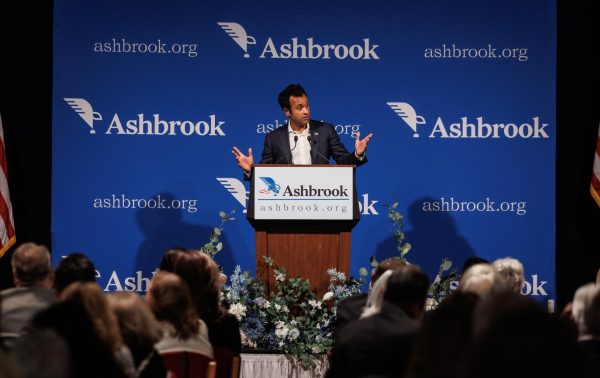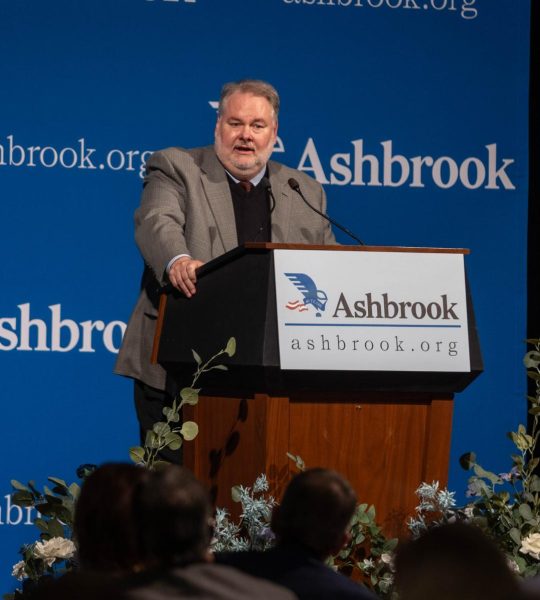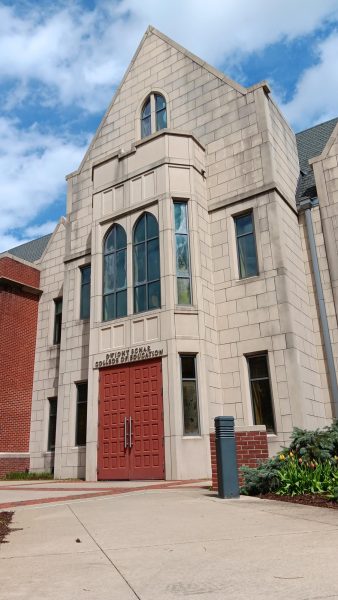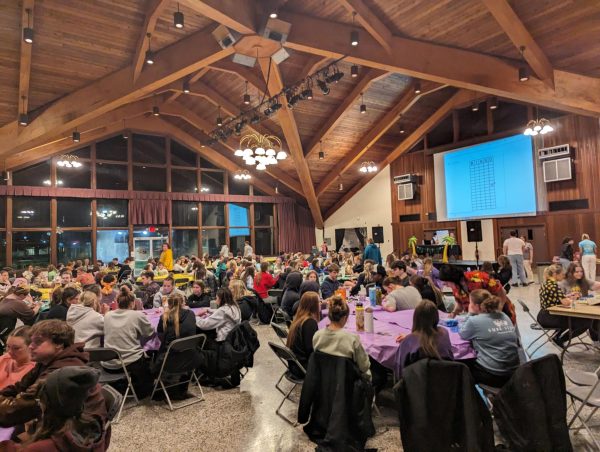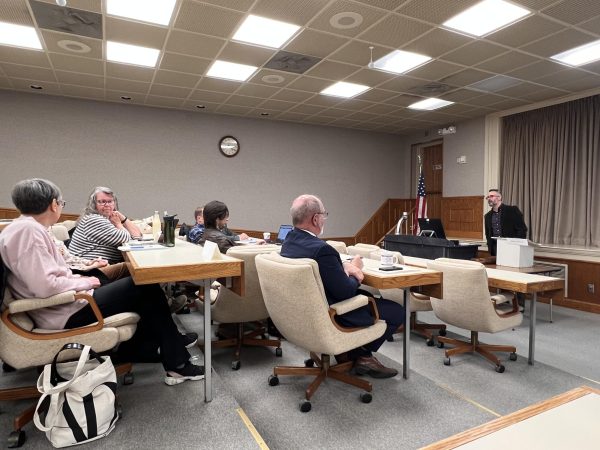Rec Center doing well for a ‘small school in Ohio’
March 24, 2011
After a long day of classes, work and Convo food, many Ashland University students shake off stress and boredom by going to the Recreational Center. Despite the basketball games, treadmills and free weights, some students might also note what the Rec Center is lacking in.
“I’m always really disappointed when I want to play racquetball,” junior Evan Frank said. “A lot of times, there are already people playing and then you have to wait. We should have more than two courts.”
No matter what the complaint may be, it’s rarely heard and responded to by a faculty member who could explain the whys and hows of Ashland compared to other schools.
Ashland, Findlay and Dayton’s Rec Centers were compared to explore the differences that occur amongst universities. All three universities are private; however, the enrollment statistics for 2010 reportedly showed that Findlay is the smallest school in this comparison, with more than 3,900 students. Ashland had around 6,500 students and Dayton had about 11,000 – three universities, three dissimilar sizes, three different Rec Centers.
Hours
Ashland
According to the recreational services page on AU’s website, the weights, exercise equipment and courts are never used by official athletic teams so students can always have access. Athletic teams practice in other places, giving students as much time as possible to use the equipment provided.
Ashland’s pool consists of competition lanes, a diving well and a small whirlpool (hot tub) located close by. A sauna is located between the men’s and women’s locker rooms. The pool is used by the swim team between 2 p.m. and 6 p.m., so it is not always open to all students at all times. However, Director of Rec Services Janel Molnar said that the hours taken away from students for the team are used well.
“There is a lot of exposure for the swim team now,” Molnar said, referring to the difference between the new pool that was opened when the Rec Center was built in 2006 and the pool that AU had previously used.
Another feature of the Rec Center is its rock climbing wall, which hosts a 12-footbouldering wall, as well as five 24-foot rope courses, according to the AU website.
“I’ve wanted to try the rock climbing wall,” sophomore Crystal Ankney said. “I just have no motivation to do it.”
Overall, students seem to agree that the Rec Center hours are working well and that, for the most part, they are all fair and fulfill what the students have paid for.
“I don’t really have a problem with the Rec or their hours,” junior Erin Krutschnitt said. “Maybe the [yoga] rooms should be available more. There’s always something going on in them.”
Findlay
Findlay’s listed hours of operation were provided by Bryan Golding, the director of The University of Findlay’s Rec Services department. Findlay’s Rec Center does not house a pool; it is located in another facility. Findlay’s rock climbing wall was added recently and is only closed on Saturdays and Sundays.
One thing that Findlay has that the other schools do not are student weight room hours, as oftentimes there are athletic teams that use the weight room for themselves. Findlay has a cardio center as another option for students when the weight room is occupied.
“The cardio center is all machines,” Bridget Messaros, a Findlay junior, said. “I like free weights more than machines so I kind of wish that I could use [them], but the weight room is usually “rented” out by athletic teams…so I just go to the cardio center to work out.”
Messaros went on to explain that the weight room in the Findlay Rec Center was built mainly for the athletic teams and less for students’ overall use. There was a separate weight room in another building, but it was getting too small for the teams.
“We have to share certain areas of buildings with athletic teams,” Messaros said, “but they’re pretty good with making …it work.”
Besides the weight room, Findlay’s Rec Center track is also used by cheerleaders and the track team. Thus, for two to three hours a day, the track is not open to students, either.
Dayton
Dayton’s hours of operation change, depending on whether it is the fall or spring semester, according to Assistant Director of Facilities Operations Abby Whaley. The graph shown lists the times in the fall; in the spring semester, the nights listed that say midnight are extended to 1 a.m.
Dayton has an Aquatic Center which houses three pool areas, according to the official website. They have a competition pool, a leisure pool and a diving well. The center also has an eight person spa.
“I love the hot tub,” Stephanie Walton, a Dayton freshman, said. “That seems to be my favorite.”
Walton thinks that the hours at Dayton are fine and she has never had a problem with them. She is on the rowing team at Dayton and practices somewhere else, as do most of the other athletic teams. As with Ashland, Dayton’s Rec Center is mainly geared towards students and athletics must practice in other designated areas.
The only hours Walton wonders about are the rock climbing wall hours.
“The rock wall seems to not be used enough,” Walton said. “But it has limited hours, so that might be why.”
The wall has two climbing routes for beginners and intermediate climbers. There is also a bouldering cave.
Main Attractions
Ashland
As stated earlier, Ashland’s Rec Center prides itself on having separate places for athletic teams to work out, so that the Rec is open to students as often as possible. Besides this, the Rec also stands out by having a golf simulator, ping pong and pool tables and video games.
Upstairs is a jogging court that looks over the downstairs areas, which include two full basketball courts that are used for intramurals, volleyball and other sports, as well. Next to these is the MAC court, which often houses soccer. Ashland has 31 intramurals and events.
Downstairs is the fitness center with treadmills, ellipticals and free weights, among other things. There are also aerobic rooms for yoga and Group X classes, as well as two full racquetball courts. The Rec also houses several classrooms and a game room, according to the official website.
Ashland’s Rec is also home to Tuffy’s, a smoothie bar that serves out smoothies and shakes, as well as sandwiches, muffins and various blends of trail mix.
Findlay
Findlay built their Koehler Fitness and Recreation Center in 2009, according to its official website, and it is fully equipped, including four basketball courts, a track and an ice rink. Intramural basketball, volleyball, dodgeball and broomball are often played on these courts. Findlay has 28 intramural activities.
Findlay’s cardio center contains all machine weights, including treadmills and natural runners. Besides these, there are also several classrooms and a game room which provides plenty of entertainment for students. According to Findlay’s Golding, students have plenty of places to just relax.
“Students can hang out in the lounges,” Golding said, “play pool or ping pong, use the multi-purpose courts, play Wii, Playstation or Xbox and watch movies.”
Findlay also just recently opened a juice bar called Derricks, which strives to promote healthy food and beverage choices.
Dayton
Like Findlay, Dayton also has a four court gym. Other attractions include a MAC gym, three racquetball courts and a group fitness studio. There are over 35 intramurals offered throughout the year, according to Whaley.
According to the official website, Dayton’s fitness center has over 60 pieces of cardio equipment and an indoor track, as well as small and large classrooms. Whaley thinks that the amount of space and time put into the Rec is a good thing.
“We pride ourselves on providing wholesome recreational-fitness experiences that contribute significantly to the student’s social, psychological, physical, and creative well-being, as well as overall opportunities for student development,” Whaley said.
Dayton also houses a smoothie bar called The Chill and it makes “excellent smoothies and juices,” according to Walton.
Cost and Employment
Ashland
The prices listed for Ashland’s Rec Center costs were acquired from a membership application sheet, as well as speaking with Molnar. Molnar said that the $85 students pay per semester only goes towards paying off the five-year-old Rec and has nothing to do with buying equipment or profit.
“That money goes towards paying off the building,” Molnar said. “That’s it. None of that money comes to us.”
Ashland is not open to the community unless they are directly connected to someone affiliated with AU who is willing to sponsor them. Alumni are only allowed to visit on the weekends, so their costs are cheaper due to their limited times.
The Rec Center is the largest employer on campus, with 122 students working the various areas of the building, including front desk, weight room observation and referees.
Findlay
The prices listed for Findlay were provided by Golding.
“There is no additional fee for use of the facility,” Golding said. “We do have a student activity fee for campus, but I do not receive any money from this fee and [it] has been in place way before our facilities were built.”
Findlay is not open to the community unless a community member is sponsored by Findlay staff, faculty or alumni.
Findlay is the second largest employer on campus, providing 103 students with jobs.
Dayton
Prices listed in the chart were found on Dayton’s official website.
Dayton has a large category of memberships that can be found on the website, and it is not open to the community unless they are sponsored by a current Dayton faculty or staff member.
One thing that makes Dayton stand out is the faculty and staff memberships are made $100 cheaper by allocations from Human Resources for every individual or family membership sold under the faculty/staff category, according to Whaley.
Dayton employs 250 students and is usually the largest or second largest employer on campus, varying from year to year.
Results
In the end, Dayton’s Rec has the most extensive hours of business, which fits since they have a larger amount of students than Findlay or Ashland. Findlay also has longer hours of operation than Ashland does, even though Ashland has a larger student body.
All of the schools seem to be doing well with the main attractions and host about the same amount of intramurals. They all have juice bars, weight or cardio centers, and classrooms. However, Findlay does not house a pool in their Rec Center.
Dayton is the most expensive rec center on the list, with Findlay being the cheapest. Ashland students’ money is helping pay off the building, and when it is paid off, perhaps there will be a change in price. All of the rec centers help with student employment, coming in as the first or second largest employer on their respective campuses.
In the end, Molnar thinks that AU is measuring up just fine.
“For a small school in Ohio, we offer great programs and facilities,” Molnar said. “We’re doing what these other schools are doing, just on a smaller scale at a smaller school.”



